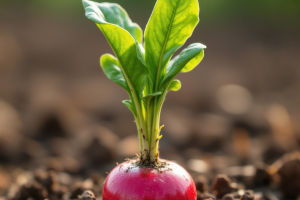Plants and Soil Fertility
Soil fertility is the foundation of healthy ecosystems and agricultural productivity. Without fertile soil, crops struggle to grow, and ecosystems can suffer. One often overlooked contributor to soil fertility is plants themselves.
From enriching the soil with essential nutrients to maintaining soil structure, plants play a crucial role in promoting soil health. In this article, we will explore how plants contribute to soil fertility, enhance agricultural productivity, and support the environment.
Plants and Soil Structure
Plants significantly influence the physical properties of soil. The roots of plants help to create a well-structured soil environment by binding soil particles together, forming aggregates. These aggregates create spaces between soil particles, which improve water infiltration and root Invasion.
The improved soil structure increases the soil's ability to hold air and water, creating a favorable environment for plant growth. Furthermore, the root systems of plants prevent soil erosion by stabilizing the soil and protecting it from the forces of wind and water.
Decomposition of Plant Material: A Source of Organic Matter
When plants die or shed their leaves, flowers, and roots, these organic materials break down in the soil through the process of decomposition. Decomposers, such as bacteria, fungi, and earthworms, help break down plant matter into smaller components.
This organic matter, often referred to as humus, is rich in essential nutrients like nitrogen, phosphorus, and potassium. Humus also helps to improve soil structure by enhancing its moisture retention capacity and nutrient-holding ability. Over time, the accumulation of organic matter contributes to the long-term fertility of the soil.
Nitrogen Fixation: A Natural Fertilizer
One of the most important contributions of plants to soil fertility is nitrogen fixation. Certain plants, particularly legumes like beans, peas, and clover, have a symbiotic relationship with nitrogen-fixing bacteria in their root nodules.
These bacteria convert atmospheric nitrogen (N₂) into ammonia (NH₃), which is a form of nitrogen that plants can absorb and use for growth. This process provides a natural source of nitrogen to the soil, enriching it and reducing the need for synthetic fertilizers. Nitrogen is essential for plant growth, as it is a key component of proteins, enzymes, and chlorophyll.
Cover Crops: Protecting and Enriching the Soil
Farmers use cover crops to protect and enhance the fertility of their soil. Cover crops, such as rye, clover, and vetch, are planted between regular cropping cycles to prevent soil erosion, suppress weeds, and add organic matter to the soil. Some cover crops, especially legumes, also fix nitrogen in the soil, further boosting its fertility. By planting cover crops, farmers can maintain a healthy soil ecosystem, reduce the risk of nutrient depletion, and increase the soil's ability to retain water.
Plants and Soil pH Balance
Soil pH is a critical factor in determining the availability of nutrients for plants. Plants can influence soil pH in various ways, either by acidifying or alkalinizing the soil. For example, plants like conifers and blueberries tend to acidify the soil, which may benefit certain crops that prefer acidic conditions.
Conversely, plants such as alfalfa and some grasses can help raise the soil's pH, making it more alkaline. These changes in soil pH can enhance the availability of specific nutrients, allowing plants to grow more efficiently.
Mycorrhizal Fungi: A Symbiotic Relationship
Plants and fungi form symbiotic relationships that benefit both organisms. Mycorrhizal fungi attach to the roots of most plants and help them absorb water and essential nutrients like phosphorus, nitrogen, and potassium. In return, the plant supplies the fungi with carbohydrates produced through photosynthesis.
This mutualistic relationship improves soil fertility by facilitating nutrient uptake and promoting soil microbial activity. Mycorrhizal fungi also contribute to soil structure by forming networks of hyphae that bind soil particles together, further enhancing soil stability.
Reforestation and Soil Fertility Restoration
Reforestation is a powerful tool for restoring soil fertility, particularly in areas that have been degraded by deforestation, overgrazing, or poor agricultural practices. When trees are planted in areas where the soil has been depleted of nutrients, their root systems improve soil structure, prevent erosion, and add organic matter to the soil through leaf litter and decaying roots.
Additionally, trees such as nitrogen-fixing species can improve soil nitrogen levels, making the soil more fertile and capable of supporting agricultural activities in the long term.
The Role of Plants in Reducing Soil Erosion
Soil erosion is a significant problem for agricultural productivity and environmental sustainability. Plants play a vital role in preventing soil erosion by stabilizing the soil with their root systems. Grasses, shrubs, and trees all contribute to holding the soil in place, preventing it from being washed or blown away by water or wind.
By reducing soil erosion, plants help maintain soil fertility and prevent the loss of valuable topsoil, which is crucial for growing crops and supporting healthy ecosystems.
Impact of Sustainable Farming Practices on Soil Fertility
The use of sustainable farming practices is essential for maintaining and improving soil fertility in the long term. Practices such as crop rotation, reduced tillage, and organic farming help protect soil health by promoting biodiversity, reducing soil compaction, and preventing nutrient depletion.
By incorporating plants that enhance soil fertility, such as nitrogen-fixing crops and cover crops, farmers can reduce their reliance on chemical fertilizers and promote a more sustainable and resilient agricultural system.
Conclusion: Plants as Guardians of Soil Health
In conclusion, plants are indispensable for maintaining soil fertility and supporting healthy ecosystems. Their ability to improve soil structure, add organic matter, fix nitrogen, and prevent erosion makes them essential players in the health of our soils.
Whether through the decomposition of plant material, the role of cover crops, or the symbiotic relationships with mycorrhizal fungi, plants actively contribute to the enrichment of the soil. By promoting sustainable agricultural practices and protecting plant-rich ecosystems, we can ensure the long-term fertility of our soils and the productivity of our lands.
Do you have any experience with soil improvement through plants? Share your thoughts in the comments below!
-
 Erosion DefenseHow Plants Help Prevent Soil Erosion: Nature’s Powerful Shield Against Land Degradation
Erosion DefenseHow Plants Help Prevent Soil Erosion: Nature’s Powerful Shield Against Land Degradation -
 Clean Air PlantsHow Certain Houseplants Can Improve Indoor Air Quality Through Natural Biological Processes!
Clean Air PlantsHow Certain Houseplants Can Improve Indoor Air Quality Through Natural Biological Processes! -
 Plant Propagation TipsEasy and Effective Ways to Propagate Your Favorite Plants at Home for a Greener Space!
Plant Propagation TipsEasy and Effective Ways to Propagate Your Favorite Plants at Home for a Greener Space!
Contact to : xyjph123@gmail.com
Privacy Agreement
Copyright © boyuanhulian 2020 - 2022. All Right Reserved.
Privacy Agreement
Copyright © boyuanhulian 2020 - 2022. All Right Reserved.